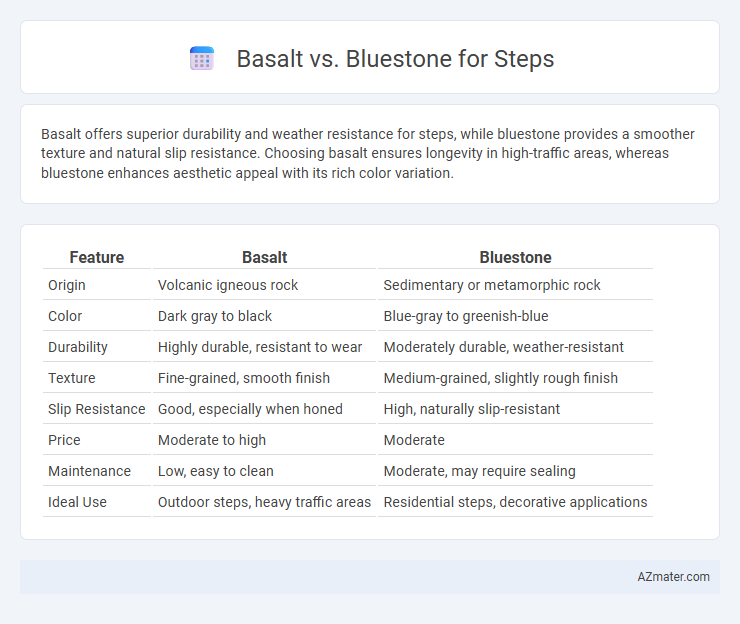Basalt offers superior durability and weather resistance for steps, while bluestone provides a smoother texture and natural slip resistance. Choosing basalt ensures longevity in high-traffic areas, whereas bluestone enhances aesthetic appeal with its rich color variation.
Table of Comparison
| Feature | Basalt | Bluestone |
|---|---|---|
| Origin | Volcanic igneous rock | Sedimentary or metamorphic rock |
| Color | Dark gray to black | Blue-gray to greenish-blue |
| Durability | Highly durable, resistant to wear | Moderately durable, weather-resistant |
| Texture | Fine-grained, smooth finish | Medium-grained, slightly rough finish |
| Slip Resistance | Good, especially when honed | High, naturally slip-resistant |
| Price | Moderate to high | Moderate |
| Maintenance | Low, easy to clean | Moderate, may require sealing |
| Ideal Use | Outdoor steps, heavy traffic areas | Residential steps, decorative applications |
Introduction to Basalt and Bluestone
Basalt is a dense, volcanic igneous rock known for its durability and dark, rich hues, making it ideal for outdoor steps that require strength and longevity. Bluestone, a sedimentary rock primarily composed of sandstone or limestone, offers a smooth texture and a range of blue-gray tones favored for decorative and functional stair applications. Both materials are popular choices in landscaping and architecture, distinguished by their geological origins, color variations, and weather resistance.
Geological Origins and Composition
Basalt and bluestone differ significantly in geological origins, with basalt formed from rapid cooling of lava rich in iron and magnesium during volcanic eruptions, classified as an extrusive igneous rock. Bluestone is a sedimentary or metamorphic rock predominantly composed of sandstone or feldspathic sandstone, depending on the region, often containing quartz and calcite. The mineral composition of basalt results in a dense, hard texture ideal for durable steps, while bluestone's layered structure provides a more textured surface with natural slip resistance suitable for outdoor landscaping.
Appearance and Color Variations
Basalt steps feature a sleek, dark gray to black hue with a smooth, consistent texture that lends a modern and elegant appearance. Bluestone offers a wider color range, including shades of blue, gray, green, and tan, providing more versatility for design preferences. Both stones provide distinctive aesthetics, with basalt showcasing uniformity and bluestone delivering natural, varied color patterns ideal for diverse architectural styles.
Durability and Strength Comparison
Basalt offers superior durability and density compared to bluestone, making it highly resistant to wear and weathering in outdoor steps. Bluestone, while strong and versatile, typically has a slightly softer composition, resulting in modestly less resistance to heavy foot traffic and environmental stress. For step applications requiring maximum strength and longevity, basalt is often the preferred material due to its exceptional hardness and structural integrity.
Slip Resistance and Safety for Steps
Basalt offers superior slip resistance on steps due to its naturally rough texture and dense composition, making it ideal for safety in wet or high-traffic areas. Bluestone provides moderate slip resistance but may require surface treatments or texturing to enhance grip and ensure safety on steps. Choosing basalt for steps prioritizes slip resistance and minimizes slip-and-fall hazards, critical for both residential and commercial applications.
Weather Resistance and Longevity
Basalt exhibits superior weather resistance due to its dense, non-porous structure, making it highly durable against freeze-thaw cycles and moisture infiltration. Bluestone, while durable, is more porous and prone to erosion and staining over time, reducing its longevity in harsh weather conditions. For outdoor steps exposed to variable climates, basalt ensures extended lifespan and minimal maintenance compared to bluestone.
Installation Process and Maintenance
Basalt steps require precise cutting and professional installation due to their dense, igneous composition, ensuring durability and a smooth finish. Bluestone, being a sedimentary rock, is easier to shape and install, often accommodating DIY projects with basic tools. Maintenance for basalt involves regular sealing to prevent staining and weathering, while bluestone benefits from routine cleaning and occasional resealing to maintain its natural color and texture.
Cost Factors and Budget Considerations
Basalt steps typically cost more upfront due to their durability and dense composition, which leads to higher quarrying and transportation expenses compared to bluestone. Bluestone is generally more budget-friendly, offering a balance between aesthetic appeal and affordability, making it a popular choice for projects with moderate budgets. Maintenance costs for basalt tend to be lower over time, but initial investment and regional availability heavily influence overall budget considerations.
Sustainability and Environmental Impact
Basalt and bluestone both offer sustainable choices for steps, with basalt being a natural volcanic rock known for its durability and minimal environmental processing. Bluestone, primarily a sandstone, is sourced from quarries with varying environmental practices, impacting its sustainability footprint depending on extraction methods. Selecting locally quarried basalt or bluestone can reduce transportation emissions, enhancing overall environmental benefits for step installations.
Best Applications: Choosing Between Basalt and Bluestone for Steps
Basalt is ideal for steps requiring high durability and slip resistance, making it perfect for outdoor staircases exposed to harsh weather. Bluestone offers a smooth, elegant finish that suits formal garden steps and interior staircases, enhancing aesthetic appeal. Selecting between basalt and bluestone depends on the balance between functional durability and desired visual texture for the specific step application.

Infographic: Basalt vs Bluestone for Step
 azmater.com
azmater.com